Recent Articles
Popular Makes
Body Types
10 Things You Should Know About the 2011 Hyundai Sonata Turbo and Hybrid
Hyundai takes on class leaders with horses and polymers
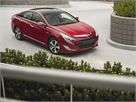
At 37, single and without kids, one of our editors can tell you that the search for the so-called perfect mate can be long, and potentially fruitless. Call it selective or picky, there are certain things he's looking for, like a woman who loves road trips, is comfortable to be around, and can find that delicate balance between fun and responsibility. Oh, and no gold diggers. He wants the whole package. If he was a car shopper, the 2011 Hyundai Sonata just might be what he's been looking for. Initially available only with a 200-horsepower four-cylinder, Hyundai is now expanding the 2011 Sonata's lineup with a bounty of boost on one end and a new approach to gas/electric efficiency on the other. With the debut of the 2.0T and Hybrid variants, a wide swath of shoppers will find the fuel economy, performance, comfort, and value that fit their needs and lifestyle. And it's all under the Sonata banner. Photos courtesy of Hyundai
#10. Turbocharged Sonata pricing starts at $24,865
When Hyundai launched the 2011 Sonata earlier this year, buyers could choose from GLS, SE and Limited models, all powered by a 2.4-liter, normally aspirated four-cylinder engine. Roughly ten months later, the company is debuting a duo of turbocharged versions: SE 2.0T and Limited 2.0T. Base prices range from $24,865 to $27,765 including destination charges, but aside from the extra power under the hood, features vary little from existing SE and Limited variants. Exceptions include a standard dual-zone climate control system for the SE 2.0T and an upgraded sound system, heated front and rear seats, and a moonroof for the Limited 2.0T. If you have a few dollars left over, Hyundai would be happy to supply you with an optional navigation system and rearview camera, a 400-watt Infinity sound system, and more.
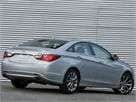
#9. Pricing for the Hyundai Sonata Hybrid starts at...?
Hyundai is waiting until November to release pricing for the Sonata Hybrid. Until then, we can tell you that the company's first gas/electric model will be available in one well-equipped version. Among the standard features are heated mirrors, Bluetooth connectivity, an eight-way power driver's seat, as well as USB and iPod input jacks. You'll also find 16-inch alloy wheels, leatherette interior trim, dual-zone climate control, and a 4.2-inch hybrid display in the center of the gauge cluster. Should that plethora of not-so-basic amenities leave you wanting, consider fitting the Sonata Hybrid with an available Premium Package. This is essentially the model's mac daddy of options, boasting a touch-screen navigation and rearview camera system, leather upholstery, a panoramic sunroof (not available on any other Sonata model), premium interior trim, heated front and rear seats, and the 400-watt Infinity sound system.
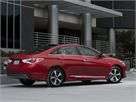
#8. 2011 Sonata Hybrid styling is more distinct than the Sonata Turbo
One of the factors that has led to the 2011 Hyundai Sonata's success is its aggressive styling, accented by sharply wedged headlights and dramatic creases in the hood and flanks. Not surprisingly, the 2.0T variants stick with the look that's been working, including 18-inch silver alloy wheels, foglights, and a sizeable chrome grille. The only obvious clue to what's under the hood can be seen on the trunk lid, where you'll find a 2.0T badge. The Sonata Hybrid (pictured), by contrast, carries styling cues that clearly set it apart from the rest of the pack. Up front is a distinct bumper with a black mesh grille positioned low, reshaped foglights, unique 16-inch alloy wheels (17s are optional), and a chrome accent wedge on the bottom of the doors. Rounding things out are LED elements in the headlights and taillights.
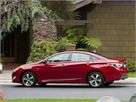
#7. 2011 Sonata's four cylinders deliver more power and efficiency than rivals' V-6s
Among the Sonata's competitors, lineups usually include a base four-cylinder engine as well as an optional V-6, and, in some cases, a hybrid variant. Hyundai has the four-banger covered, and will soon be offering the Sonata Hybrid, but you'll be hard-pressed to find a V-6. Filling the void is a turbocharged, 2.0-liter powerplant sporting continuously variable valve timing and direct injection technology. Output is what we'd call plentiful, measuring 274 horsepower and 269 lb.-ft. of torque. Those figures are greater than what you'll find in any of the Sonata's V-6-powered rivals, but that's not the end of the story. Thanks to the employment of direct injection and a six-speed automatic transmission tuned to deliver equal parts response and efficiency, the boosted Sonata returns an estimated 22 mpg in the city and 33 mpg on the highway. Regular-grade fuel - the relatively cheap stuff - is recommended.
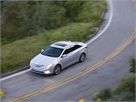
#6. Worried about turbo lag in the turbo Sonata? Don't be
The Sonata 2.0T is the first turbocharged Hyundai sedan offered to U.S. car buyers. As many manufacturers will attest, delivering smooth boosted power is a challenge, but it's one Hyundai has confidently met with its new juiced 2.0-liter. That best-in-class output is provided without any hint of turbo lag, meaning drivers enjoy immediate throttle response. The four-cylinder is as comfortable traveling at slow speeds around town as it is zeroing in on triple digits on the open road. Hyundai has made special effort to keep interior noise to a minimum, but the engine's unrefined note makes itself heard, as do the rolling 18-inch tires. Serving as the conduit between the engine and the rubber that hits the road is a six-speed automatic transmission. Gear changes are smooth, and downshifts come quickly and easily with a gentle prod of the gas pedal. There is a manual mode actuated by the shift knob or paddles behind the steering wheel, but we found its slow reactions actually detracted from the driving experience. After traveling on a variety of roads and subjecting our test car to periods of generous throttle application, we averaged just over 30 mpg.
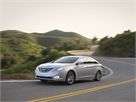
#5. Hyundai uses a unique hybrid system in the 2011 Sonata to maximize highway fuel economy
Most of today's mainstream hybrid sedans draw power from a small four-cylinder engine mated to a nickel-metal hydride (NiMH) battery pack, a continuously variable transmission (CVT), and an electric motor. The batteries are relatively inexpensive and the CVT typically delivers greater fuel economy than a traditional automatic. The Sonata Hybrid follows that lead with a 2.4-liter, four-cylinder engine and a 270-volt electric motor. From there, engineers steered in a different direction with the use of lithium polymer batteries, which can be packaged into a smaller space while still delivering a longer cycle. The Sonata's battery weighs 96 pounds, or 19 pounds less than the NiMH unit found in the Nissan Altima Hybrid. Net horsepower comes in at 206. Unlike its competitors, the Sonata Hybrid works with a traditional six-speed automatic transmission. Hyundai cites an SAE study that found that 58 percent of hybrid drivers spend most of their time on the highway, where the automatic six-cogger proves more efficient. Aerodynamics has also been addressed with a unique front-end design and a set of flaps behind the grille that activate at higher speeds to reduce wind resistance. As a result of this focus, the Sonata Hybrid differs from competitors like the Ford Fusion Hybrid and Nissan Altima Hybrid by recording its greatest efficiency, 40 mpg, on the highway. City fuel economy is rated at 36 mpg.
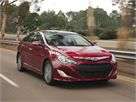
#4. The Sonata Hybrid drives like any other underpowered four-cylinder sedan
For the most part, hybrid vehicles operate much like their traditional gasoline-powered counterparts, though there remain some subtle differences. In terms of the 2011 Hyundai Sonata Hybrid, those include brakes that are a little grabby and not quite as easy to modulate as other Sonata models, and displays that show whether power is coming from the battery, the engine, or both. Hyundai claims that, under the right conditions, the Sonata Hybrid can operate at up to 62 mph on electric power alone. We didn't have that experience, though our Managing Editor did direct us to operate the car as any other sedan, avoiding any urge to change our style to maximize fuel economy. With that mindset, we found the 206 net horsepower rating hard to believe on hills and when accelerating from a stop. Maintaining speed required planting the throttle on inclines, and even gradual slopes caused the transmission to frequently hunt for the appropriate gear. As a result, and despite the involvement of regular and regenerative braking, the battery pack was slow to recharge. Over the course of a 30-mile test, we averaged 35.2 mpg.

#3. Regardless of what's under the hood, the 2011 Hyundai Sonata delivers solid handling
Hyundai has developed a positive reputation for a lot of things over the years, but nimble handling hasn't been one of them. However, the brand's newer products, including the 2011 Sonata, promise more sport than ever before. During our run in the Limited 2.0T we found the suspension to be on the firm side. When tackling corners, the slightly heavy electric steering responded well, though it didn't serve up an abundance of road feel. The 18-inch tires provided a commendable level of grip. Braking power was reassuring, with an easily modulated pedal and no hints of fade or shudder after some aggressive driving. Hopping behind the wheel of the Sonata Hybrid, we expected a softer and floatier experience, yet in reality the ride was much like the rest of the Sonata lineup. The brakes were more sensitive, but the steering actually felt a smidge more responsive than in the Limited 2.0T. In normal driving, we didn't notice any discernable difference in ride quality, and since our brief drive didn't allow for any canyon carving, we can't comment on how well the Sonata Hybrid manages the twisties. If that's what floats your boat, better to consider the turbocharged version anyway.
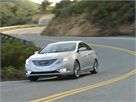
#2. The Sonata's interior comfort and functionality are impressive
After a recent test of the 2011 Sonata's corporate cousin, the redesigned Kia Optima, we couldn't criticize the miserable front seats enough. That's not an issue in the Hyundai, where spacious and well-contoured buckets serve the driver and front passenger, and a comfortable bench with generous space welcomes the backsides of up to three rear-seat occupants. A tilting and telescopic steering wheel and multiple power adjustments help the driver find a suitable position, a wide armrest is positioned between the seats, and all of the primary controls are within easy reach. Designers borrowed styling cues from various manufacturers for the instrument panel, with radio buttons laid at an angle below the optional navigation system's touch screen, and climate controls shaped like a seated driver.
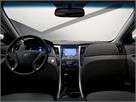
#1. The Sonata 2.0T is another winner for Hyundai. The Sonata Hybrid is a strong contender
Choices abound in the family sedan market, where players like the Honda Accord, Toyota Camry, Nissan Altima, Ford Fusion, and Chevrolet Malibu battle for shoppers' attention. The redesigned Hyundai Sonata served them all notice with its aggressive styling, comfortable and spacious cabin, available amenities, efficiency, and value. The debut of the Sonata 2.0T takes the game to a higher level, with a combination of power and fuel economy unmatched by those highly respected competitors. There's much to praise about the Sonata Hybrid, too, from its lightweight battery pack to its 206 net horsepower and 40-mpg highway rating. Unfortunately, the drive isn't terribly engaging. Honestly, we had more fun driving a 2010 Toyota Prius in which we averaged about 44 mpg. Simply put, the Sonata 2.0T is the new one to beat, whereas the Sonata Hybrid is the new one to consider.
